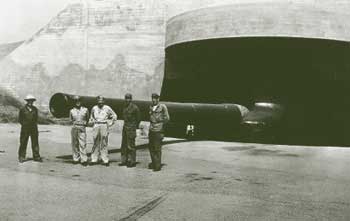Battery Paul D Bunker, BCN-127
Two 16" BCLR Battery
By the beginning of World War
Two, the disappearing guns originally installed on the upper
reservation of Fort MacArthur were considered to be
obsolete due to a lack of range and overhead protection.
As far back as 1932, the US Army had begun experimenting
with the idea of using a number of surplus 16" navy guns for
coast defense. Over the next ten years, a number of
prototype batteries were constructed in both the United States and Panama.
|

A US Army caretaker crew poses around one
of the guns at Battery Bunker (BCN-127) in 1946 |
|

Battery Bunker in action during a test
firing in 1944 |
The end result was a standardized design that could be
built almost anywhere the army needed from a standard
set of blueprints that needed little modification based
on local terrain.
Battery construction project 127 began at the Whites
Point reservation in April of 1942.Two huge concrete gun
emplacements were built at a cost of 1.2 million
dollars. The new battery featured such improvements as
both radar and optical fire control, substantial
overhead protection, and two 16 inch 50 caliber Mark II
naval guns.
The new battery had a range of over 26 miles and the
fort now had the ability to cover the entire northern
approach to the Los Angeles Harbor. An identical battery
of this design was built at the Bolsa Chica reservation,
Battery 128 was intended to cover the southern
approach but that battery was never armed before the war
ended.
War Department General Order 51 issued on June 10, 1946
officially changed the name of the battery 127 to honor
the memory of Colonel Paul Delmont Bunker. Colonel Bunker
was a member of the organized reserve corps of the Coast
Artillery at Fort MacArthur from 1937 - 1940. |
Colonel Paul Delmont Bunker (1861-1943) a graduate
of the US Military Academy at West Point class of
1903. Paul Bunker is considered an immortal in the
game of football at West Point. He was twice named
to Walter Camp's All American Team in 1901 and
again in 1902. The competitive and determined
spirit that drove him on the field was symbolic of
his attitude thought his military career. It was
said that Paul Bunker loved life and worked hard
to live it thoroughly.
“In 1915 he reported for duty with the 59th Coast
Artillery at Fort Mills (Corregidor Island) in the
Philippines. He would later command this regiment
twice, the later time was when the fort fell to
the Japanese. Over the next 20 years, Bunker moved
from assignment to assignment including command of
Fort Amador, Panama from 1919-1921 as well as Fort
Totten at Willets Point in New York. In 1935,
Colonel Bunker returned to the Philippines to
command his old regiment on Corregidor. While he
was there he came to truly appreciate islands and
its people.”
Paul Bunker returned to the United States in 1937
and was assigned to the Organized Reserve Corps of
the Coast Artillery at Fort MacArthur. Even though
he was not due for foreign service again in 1940,
the opportunity was presented to return to again
command the 59th Coast Artillery Regiment at Fort
Hughes. Over the next two years, he worked to
strengthen the islands defenses, and train both US
and Philippine forces for the inevitable conflict.
Colonel Bunker was taken
prisoner by the Japanese on May 6, 1942 and was
held in a Japanese prison camp until he died of
starvation and disease on September 7, 1943. He is
buried in the cemetery at West Point. |
|
|
|
 |
|
The Guns of Fort MacArthur |
 |
|
|
|